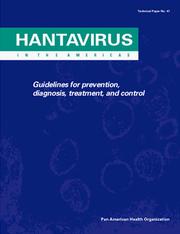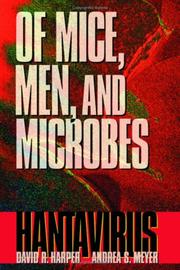| Listing 1 - 7 of 7 |
Sort by
|

Abstract | Keywords | Export | Availability | Bookmark
 Loading...
Loading...Choose an application
- Reference Manager
- EndNote
- RefWorks (Direct export to RefWorks)
HANTAVIRUS INFECTIONS --- HANTAVIRUS INFECTIONS --- HANTAVIRUS INFECTIONS --- HANTAVIRUS PULMONARY SYNDROME --- PREVENTION AND CONTROL --- DIAGNOSIS --- DRUG THERAPY --- HANTAVIRUS INFECTIONS --- HANTAVIRUS INFECTIONS --- HANTAVIRUS INFECTIONS --- HANTAVIRUS PULMONARY SYNDROME --- PREVENTION AND CONTROL --- DIAGNOSIS --- DRUG THERAPY
Book
Year: 2020 Publisher: Frontiers Media SA
Abstract | Keywords | Export | Availability | Bookmark
 Loading...
Loading...Choose an application
- Reference Manager
- EndNote
- RefWorks (Direct export to RefWorks)
This eBook is a collection of articles from a Frontiers Research Topic. Frontiers Research Topics are very popular trademarks of the Frontiers Journals Series: they are collections of at least ten articles, all centered on a particular subject. With their unique mix of varied contributions from Original Research to Review Articles, Frontiers Research Topics unify the most influential researchers, the latest key findings and historical advances in a hot research area! Find out more on how to host your own Frontiers Research Topic or contribute to one as an author by contacting the Frontiers Editorial Office: frontiersin.org/about/contact
Medicine --- Immunology --- chemokine --- CVB3 --- Hantavirus --- hcmv --- HIV --- Inflammation --- influenza --- interferon --- chemokine --- CVB3 --- Hantavirus --- hcmv --- HIV --- Inflammation --- influenza --- interferon

ISBN: 012326460X 9786611005238 1429478683 1281005231 0080491987 9780123264602 9781429478687 9780080491981 Year: 1999 Publisher: San Diego Academic Press
Abstract | Keywords | Export | Availability | Bookmark
 Loading...
Loading...Choose an application
- Reference Manager
- EndNote
- RefWorks (Direct export to RefWorks)
In May 1993, a cluster of cases of a lethal disease among healthy young people brought the attention of the world to the southwestern deserts. A previously unknown disease was killing up to 80% of the people it infected.The reaction in the area and across the nation mixed fear, lack of information, and the struggles of doctors to save the victims of an unknown killer with hard science and the age old rhythmns of the desert. What came out was the story of a virus that had been killing since man arrived in the American continents, Hantavirus, with deadly relatives across the Americas and acr
Hantavirus infections. --- Hantaviruses. --- Mice as carriers of disease. --- Hantavirus infections --- Mice as carriers of disease --- Epidemics --- Disease outbreaks --- Diseases --- Outbreaks of disease --- Pestilences --- Communicable diseases --- Rodents as carriers of disease --- Hantavirus diseases --- Virus diseases --- Hantavirus --- Bunyaviruses --- Outbreaks --- Pandemics --- HANTAVIRUS INFECTIONS --- RODENTIA --- RODENT CONTROL --- COMMUNICABLE DISEASES --- HANTAVIRUS --- PREVENTION AND CONTROL

ISBN: 1555811418 Year: 1998 Publisher: ASM Press,
Abstract | Keywords | Export | Availability | Bookmark
 Loading...
Loading...Choose an application
- Reference Manager
- EndNote
- RefWorks (Direct export to RefWorks)
Cholera --- Hantavirus infections --- Herpesvirus, kaposi sarcoma-associated --- Leptospirosis --- Malaria --- Plague --- Prion diseases --- Yellow fever virus
Book
Year: 2005 Publisher: [S.l.] : Belgian Wildlife Disease Society (BWDS),
Abstract | Keywords | Export | Availability | Bookmark
 Loading...
Loading...Choose an application
- Reference Manager
- EndNote
- RefWorks (Direct export to RefWorks)
Belgium --- Animals, wild --- Communicable diseases, emerging --- Influenza A virus --- Hantavirus --- West Nile virus --- Paratuberculosis --- Tularemia --- Echinococcosis --- Trichinella --- Belgium --- Animals, wild --- Communicable diseases, emerging --- Influenza A virus --- Hantavirus --- West Nile virus --- Paratuberculosis --- Tularemia --- Echinococcosis --- Trichinella
Book
ISBN: 3038423920 3038423939 Year: 2017 Publisher: MDPI - Multidisciplinary Digital Publishing Institute
Abstract | Keywords | Export | Availability | Bookmark
 Loading...
Loading...Choose an application
- Reference Manager
- EndNote
- RefWorks (Direct export to RefWorks)
The Bunyaviridae is the largest family of RNA viruses, with over 350 isolates worldwide distributed into five genera (i.e., Hantavirus, Orthobunyavirus, Nairovirus, Tospovirus, and Phlebovirus). Many of these viruses are significant human or agricultural pathogens. The increasing number of reports on new emerging bunyaviruses and infection episodes makes it essential that we obtain a comprehensive understanding of bunyaviruses and their infection mechanisms. Although all bunyaviruses possesses a tripartite, negative-sense (or ambi-sense) RNA genome, they exhibit substantial differences in their structure, genome organization and replication strategies, which make functional interpolation across genus boundaries difficult. Fortunately, the bunyavirus field has witnessed many exciting new findings and breakthroughs in recent years. These discoveries span a wide spectrum of research areas, including structural characterization of viruses and viral proteins, the identification of new viruses, investigations into host switch and vectors of transmission, genome-based analysis of virus evolution and phylogenetic lineages, the development of new research tools, such as replicons and reverse genetics, molecular characterization of the virus life cycle at the cell level (i.e., cell entry, replication, transcription, translation, genome packaging, reassortment, and virus assembly, etc.), studies of virus–host interactions and host antiviral defense, the development of vaccines/drugs and the use of bunyaviruses for novel applications. This book includes both research and review papers that together provide a glimpse into the latest research on bunyaviruses and, at the same time, highlight some of the important research achievements made in recent years. Study topics of both a fundamental and applied nature are collated. An informed perspective for future research directions is provided and can stimulate research in some of the understudied areas.
Nairovirus --- Tospovirus --- Reverse genetics --- Orthobunyavirus --- Vectors and transmission --- Bunyavirus entry --- Bunyavirus replication --- Emerging diseases --- Virus-host interactions --- Viral immunity --- Bunyaviridae --- Bunyavirus assembly and release --- Vaccine development --- Hantavirus --- Antiviral therapeutics --- Phlebovirus
Book
Year: 2021 Publisher: Basel, Switzerland MDPI - Multidisciplinary Digital Publishing Institute
Abstract | Keywords | Export | Availability | Bookmark
 Loading...
Loading...Choose an application
- Reference Manager
- EndNote
- RefWorks (Direct export to RefWorks)
Viruses exhibit an elegant simplicity as they are so basic, but so frightening. Although only a few are life threatening, they have substantial implications for human health and the economy, as exemplified by the ongoing coronavirus pandemic. Viruses are rather small infectious agents found in all types of life forms, from animals and plants to prokaryotes and archaebacteria. They are obligate intracellular parasites, and as such, subvert many molecular and cellular processes of the host cell to ensure their own replication, amplification, and subsequent spread. This Special Issue addresses the cell biology of viral infections based on a collection of original research articles, communications, opinions, and reviews on various aspects of virus–host cell interactions. Together, these articles not only provide a glance into the latest research on the cell biology of viral infections but also include novel technological developments.
Research & information: general --- Biology, life sciences --- ectoderm --- mesoderm --- human development --- embryogenesis --- interferon response --- interferon-induced genes --- self-organizing map (SOM) data portrayal --- epigenetic signature --- embryoid body --- TGF-β and Wnt/β-catenin pathway --- interferon --- tumor necrosis factor --- STAT --- interferon regulatory factor --- antiviral --- autoimmunity --- inflammation --- hepatitis C virus --- HCV --- erlin-1 --- erlin-2 --- host factor --- endoplasmic reticulum --- RNA replication --- protein production --- virus production --- lipid droplet --- TAP-GFP --- fluorescent TAP platform --- antigen presentation --- MHC I --- immune evasion --- BoHV-1 UL49.5 --- virus --- calcium channels --- calcium pumps --- virus–host interaction --- Ebola virus --- filovirus --- inclusion bodies --- NXF1 --- liquid organelles --- mRNA export --- cancer immunotherapy --- oncolytic virus --- herpes simplex virus --- immune checkpoint inhibitor --- angiogenesis inhibitor --- rabies --- uDISCO --- 3D imaging --- rabies pathogenicity --- astrocyte infection --- metabolism --- apoptosis --- autophagy --- HIV-1 spread --- cell-free infection --- cell–cell transmission --- 3D cultures --- mathematical modeling --- environmental restriction --- CAD --- pyrimidine synthesis --- HEV --- particle production --- viral replication --- virus entry --- hantavirus --- Tula virus --- replication --- factory --- RNA synthesis --- Golgi --- stress granules --- actin cytoskeleton --- nucleocapsid transport --- Arp2/3 complex --- ERAP2 --- ERAP2/Iso3 --- microbial infections --- alternative splicing --- SARS-CoV-2 --- host cell response --- coronavirus --- MERS-CoV --- SARS-CoV --- sialic acid --- Siglec --- antiviral peptide --- enveloped viruses --- membrane phosphatidylserine --- envelope disruption --- membrane damage --- antiviral autophagy --- galectin --- bacterial invasion --- adenovirus --- lysophagy --- ESCRT machinery --- cedar virus --- henipavirus --- fusion protein --- endocytosis --- biological activity --- feline coronavirus --- feline enteric coronavirus --- FECV --- feline infectious peritonitis virus --- FIPV --- feline intestinal organoids --- alphaviruses --- cell death --- mosquito --- tolerance --- ectoderm --- mesoderm --- human development --- embryogenesis --- interferon response --- interferon-induced genes --- self-organizing map (SOM) data portrayal --- epigenetic signature --- embryoid body --- TGF-β and Wnt/β-catenin pathway --- interferon --- tumor necrosis factor --- STAT --- interferon regulatory factor --- antiviral --- autoimmunity --- inflammation --- hepatitis C virus --- HCV --- erlin-1 --- erlin-2 --- host factor --- endoplasmic reticulum --- RNA replication --- protein production --- virus production --- lipid droplet --- TAP-GFP --- fluorescent TAP platform --- antigen presentation --- MHC I --- immune evasion --- BoHV-1 UL49.5 --- virus --- calcium channels --- calcium pumps --- virus–host interaction --- Ebola virus --- filovirus --- inclusion bodies --- NXF1 --- liquid organelles --- mRNA export --- cancer immunotherapy --- oncolytic virus --- herpes simplex virus --- immune checkpoint inhibitor --- angiogenesis inhibitor --- rabies --- uDISCO --- 3D imaging --- rabies pathogenicity --- astrocyte infection --- metabolism --- apoptosis --- autophagy --- HIV-1 spread --- cell-free infection --- cell–cell transmission --- 3D cultures --- mathematical modeling --- environmental restriction --- CAD --- pyrimidine synthesis --- HEV --- particle production --- viral replication --- virus entry --- hantavirus --- Tula virus --- replication --- factory --- RNA synthesis --- Golgi --- stress granules --- actin cytoskeleton --- nucleocapsid transport --- Arp2/3 complex --- ERAP2 --- ERAP2/Iso3 --- microbial infections --- alternative splicing --- SARS-CoV-2 --- host cell response --- coronavirus --- MERS-CoV --- SARS-CoV --- sialic acid --- Siglec --- antiviral peptide --- enveloped viruses --- membrane phosphatidylserine --- envelope disruption --- membrane damage --- antiviral autophagy --- galectin --- bacterial invasion --- adenovirus --- lysophagy --- ESCRT machinery --- cedar virus --- henipavirus --- fusion protein --- endocytosis --- biological activity --- feline coronavirus --- feline enteric coronavirus --- FECV --- feline infectious peritonitis virus --- FIPV --- feline intestinal organoids --- alphaviruses --- cell death --- mosquito --- tolerance
| Listing 1 - 7 of 7 |
Sort by
|

 Search
Search Feedback
Feedback About UniCat
About UniCat  Help
Help News
News